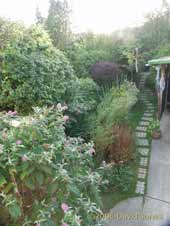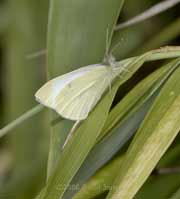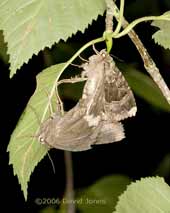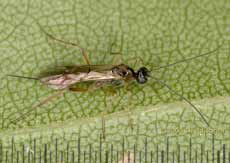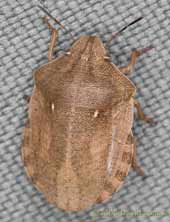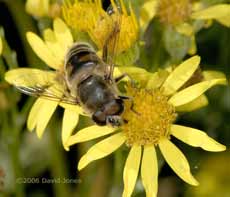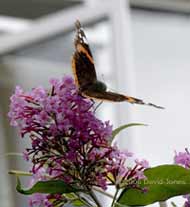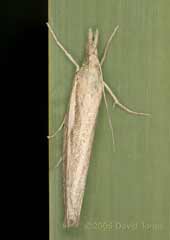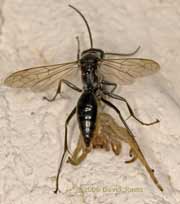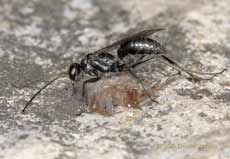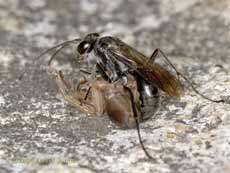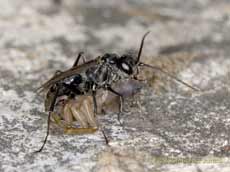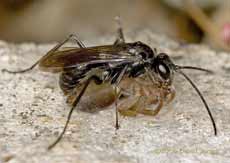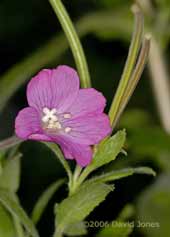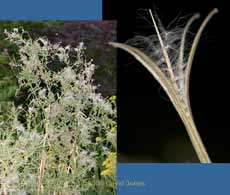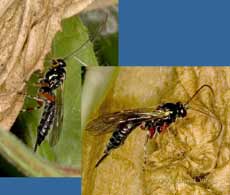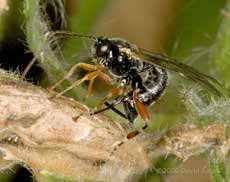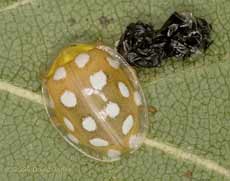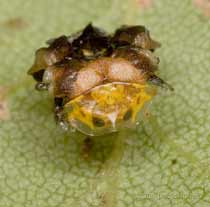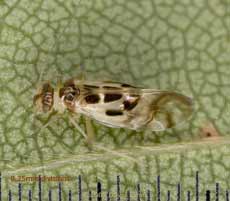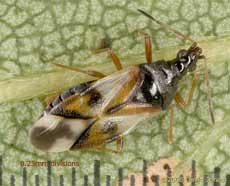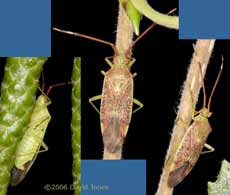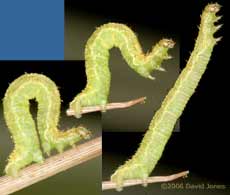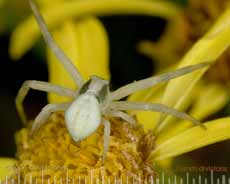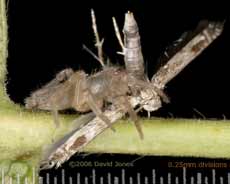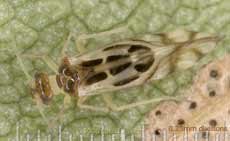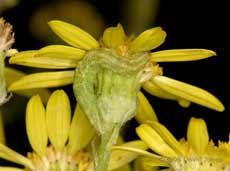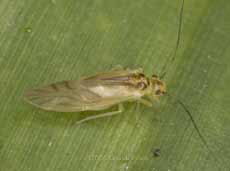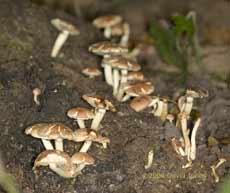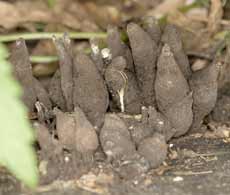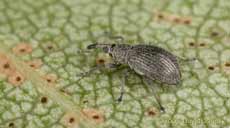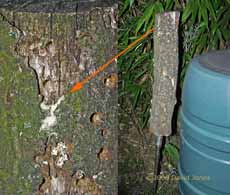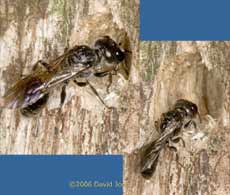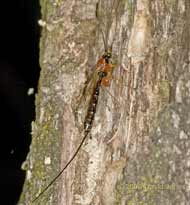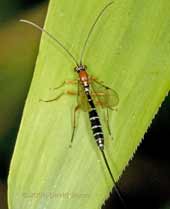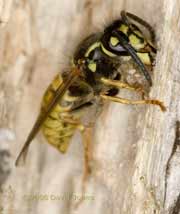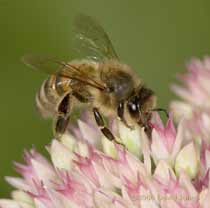Go to the last entry on this page .....Go to previous entry
Today started off warm and humid but dry, with south-westerly breeze making it very warm, reaching over 25C for a while in the afternoon. It was the best day weatherwise for a while. The picture shows the garden in the early evening as the sun dropped below the tree line.
Despite the sunshine, the only butterfly I saw in the garden was this Small White that spent time basking in the sunshine before feeding at the flowers of the Buddleia.
I didn't see any activity by Leaf-cutter bees or those solitary bees at the bee hotels today.
Last night I found another pair of Old Lady moths busy mating on the Birch tree,
There were also a few picture wing flies, owl-midges, and several small insects which could be ichneumon or other parasitic flies, including this individual with a long ovipositor, but I only saw one adult Orange Ladybird. In this picture the scale has 0.25mm divisions.
4 September - Another pleasant day, although not quite as warm as yesterday. It became overcast in the early evening with just a touch of dampness in the air. We decided to go for a drive in the morning, and headed for Wisley, the gardens of the Royal Horticultural Society. This year, the drought, along with high temperatures doesn't seem to have done many favours to some of the plants in our garden, and I wanted to see if they had any native plants on sale, and also visit the book shop. We had no luck with the plants. That was very disappointing - I would have thought that they would have had some native plants available. It looks as though I will be buying some over the web ready for next Spring.
We bought some nice books, including 'Shieldbugs of Surrey' and 'Hoverflies of Surrey', and the former was put to use almost as soon as we came home when this shieldbug turned up. Ironically, the book leaves me with a choice between Eurygaster maura or Eurygaster testudinaria. To distinguish between the species it seems that you need to look very closely at the underside of the bug - not possible as it flew off soon after the photograph was taken!
There were several kinds of hoverflies about, although I only took photographs of this Eristalis tenax which is a frequent visitor to the garden. Thanks to Roger Morris for correcting my original, mistaken identification - E. Tenax has dark feet, while E pertinax has yellow feet!
There were a couple of butterflies here during the afternoon, a Large White and this Red Admiral.
I spent a bit of time tidying up next to the big pond, and while I was there this moth was fluttering form plant to plant around the pond. I cannot be sure of its identification, but it looks very similar to a Wainscot Grass-veneer (Chilo phragmitella).
Again, there was no activity at the bee hotels, but late in the afternoon I spotted this solitary wasp visiting a couple of the unoccupied holes. I need to check if this is the same species as a similar one that I photographed earlier in the year.
I had a surprise when I caught sight of something that seemed to be having a struggle on the side wall of the house. I grabbed my camera and a set of steps to take this photograph before it flew down to the surface of our driveway. it turned out to be a solitary wasp that had caught a spider, something I hadn't seen in the garden before.
Once on the ground it carried the spider the full length of the driveway at quite a speed, making close-up photography a bit of a challenge. Several times it dropped the spider and flew about a yard or so away. It returned very quickly, although it didn't go straight to the spider, making me wonder if it was relying on 'smell' as well as sight to locate it.
Most of the time it used its jaws to hold on to the spider by the rear end of its abdomen but occasionally it would stop and seemed to be biting the front end of it.
It would then take hold of the rear again and continue on its journey.
Eventually it stopped for long enough for me to take several closer shots before it disappeared amongst gravel at what is for the moment a very untidy front of our house.
5 September - Another dry, warm and humid day, although with less sunshine than yesterday. I haven't done a huge amount today - a bit of weeding at the front of the house. That area is in a bit of a mess at the moment. Once the House Martins have taken their leave we hope to undertake some long-overdue improvements. At the moment, the only plant at the front of the house is a large Fusia plant which is a sort of family heirloom, having grown from a cutting taken from a plant in my late parents' garden many years ago. This afternoon I pruned it a little bit and took some cuttings in the hope that I can have some plants to give my sons. During the summer months the plant is covered with flowers that the bees love. On a sunny day you can't help hear the buzzing every time you open our front door.
The ovary of each flower takes the form of a long stalk behind the flowerhead. The two 'stalks' on the right of this picture have shed their flower heads and now contain developing seeds.
Today, the Willowherbs have a very fluffy look with many of the fluffy seeds being released as the seed capsules peel back.
Once they have reached this stage it is a great temptation to start clearing the Willowherbs away. However, I'm still looking out for Elephant Hawkmoth caterpillars on them (although it may be a bit late now. Previously I found them in early August) and today I saw another insect making use of one of the plants.
In fact it was Sheila who spotted this, what appears to be an ichneumon fly moving amongst the dead leaves that are found around the main stem.
Eventually it seemed to find what it was looking for, and inserted its ovipositor through one of those dead leaves. In this photograph you can see the black ovipositor pointing down into the leaf while the sheath which normally protects it is being held almost parallel to the surface. Its antennae were constantly monitoring the leaf.
Assuming that this is an ichneumon fly, I would expect that it has found a caterpillar hiding inside the curled up leaf, but I have resisted the temptation to open up the leaf to find out.
7 September - Yet another beautiful, sunny day, although with a northerly breeze it was quite chilly until the sun rose over the rooftops! This morning we had the pleasure of being hosts to Brett Westwood and Sheena Duncan of the BBC Wildlife Unit who came to record a 'chat' between Brett and myself about the garden and this website for a Radio 4 series called 'Shared Earth'. While Sheena, the producer of the series, wielded a large fluffy microphone, Brett and I wandered around the garden, talking about various aspects of the garden and its visitors, especially the insects. It was fascinating to see the different approach needed when recording for radio as opposed to television. Thanks to Sheena and Brett for making it an enjoyable morning. The series starts on 27 October and our chat is likely to be in the first program (after the broadcast the programs can be heard on the BBC website).
It is quite pale in colour compared with a mature individual, and the large image shows how its elytra (hardened front wings) and pronotum (the hardened plate that protects its thorax and head) are almost transparent around the rim of the ladybird. The lowermost white spots overlap onto this clear area.
Despite that I'm starting to see spore heads appearing on the mildew on the Birch leaves, the larvae are still few and far between, and several of the pupae that I can see are rather small. This photograph shows a sight that disappoints me - the ladybird has failed to complete its emergence from one of those small pupae and has died. I hope this is the exception rather than the rule during the Autumn.
On another Birch leaf I found what I first thought must to two small flies that were mating. I was sure that I could see two heads until I looked through the camera viewfinder and saw just the one set of legs! As is so often the case, my first attempts at identification have been fruitless (see entry for 9 Sept). The photograph, along with those above, was taken this morning. Tonight, when I checked the Birch again the fly was still on the same leaf.
I also found a couple of bugs. This first one I believe is a Common Flower Bug (Anthocoris nemorum),
and the second one is a mystery, a bug that I cannot recall seeing here before. It measures about 9mm in length (head to wing tip). If it were not for all the red on it, I think it looks very similar to a Common Green Capsid Bug. Could the red be merely a late season colouration?
8 September - Another bright and sunny day, although noticeably cooler first thing this morning, with the temperature dipping to below 10C before getting up to around 20C during the afternoon - definitely Autumnal. It's funny, but even though yesterday morning required very little effort on my part, today I feel as though I have run a marathon. As a result I have done very little in the garden, recording just one creature (other than the House Martins) with my camera.
It is a caterpillar of a moth of the family Geometridae, although I can't identify which one at the moment.
9 September - Another bright morning, although there is a layer of high cloud cover that has kept the temperature above 12C at 8am. It's always worth taking a night-time stroll down the garden, even when you should be heading for bed, and last night was no exception. I've been largely ignoring the spiders in the garden these last couple of months. At the moment the classic Garden Spiders are creating their webs across gaps all over the garden, and I must get some shots when I see a really good one. However, last night I pointed my camera at a couple of spiders that do not use a 'net' to catch their food, but are hunters instead.
Although it doesn't produce a web, it still uses silk as a 'safety line' , and if you look very closely at the large image you may just make out two incredibly thin silk strands below the end of its abdomen.
While the Crab Spider was prepared to wait for its food to arrive, on the Birch another, more active hunter had caught itself a micro-moth. This nocturnal hunter is possibly a young member of the Genus Drassodes. Its prey looks very much like an Apple Leaf Miner moth (the moth whose caterpillar makes that incredible 'hammock' to pupate in (see the July page of the diary). There are a couple more of these structures on the Birch at the moment - something I should have shown Brett during his visit!
Many thanks to Tom Ward form Burnsville, Minnesota, USA for helping me out with the mystery fly I photographed on the 7th. He has pointed me in the direction of a group of insects called Barklice (family Psocoptera). As a result of Tom's e-mail I headed for the Birch again this morning, found this single example and took a few more close-ups. I have still to identify the species, and not surprisingly there are precious few images on the web. These insects, related to booklice, feed on pollen, and the minute fungi and algae that grow on the tree's back and leaves. The name Barklice reflects their tendency to live hidden under bark!
2.30pm - We have just had lunch on the veranda and have witnessed the strangest behaviour we've ever seen by a Collared Dove. As often happens, a pair arrived as we ate. They usually feed a little, (from the feeders or on the ground) have a quick drink, and leave suddenly when something startles them. One of the birds is slightly skinnier than its partner, and today its plumage looked much smoother. Anyway, they went down to the ground to feed, ignoring each other as they did so. Suddenly, the skinny one crouched slightly and ran backwards about a foot or so at high speed. We have watched the Doves for many years but this was a surprise. As its partner was behind it I wondered if it was an aggressive move, but then it carried on feeding. However, over the next few minutes it repeated the behaviour numerous time, sometimes only taking a couple of steps, but on one occasion running backwards about 3ft, not in a straight line and not near its partner. This was one of those time when I needed a video rather than still camera! Eventually, the pair flew up to the birdbath and perched next to each other to drink, one of them making a couple of strange wailing noises (not part of their usual repertoire) before they were panicked by a wasp that came to drink next to them!
10 September - The morning started with the first, if rather thin mist of the Autumn, but it then turned into a glorious summer's day with a high of over 26C in the garden during the afternoon.
It looks as though the looper caterpillar photographed two days ago has found what it was looking for, some delicious petals on a Ragwort plant. It seems to be using its body colour to good effect as camouflage as it tackles the petals from below.
Next, what appears to be a different species of barklouse. This one seemed to be interested in the honeydew on a bamboo plant. The honey dew, a sugar-rich sticky substance, is secreted by aphids that seem to like the bamboo, and is a great source of food for a whole range of insects, from moths to hoverflies and wasps. Sadly, there are fewer aphids about to produce this 'fast food' this year.
A couple of pieces of log have sprouted the fruiting bodies of fungi. This is the nearest I can get to this one because some Stinging Nettles are in the way. I buried this piece of wood was in the corner next to the Ivy tree a number of years ago and this is the first time I've see fruiting bodies sprout from it. I can't remember what the wood is, but I think it may be Horse Chestnut. It resembles Honey Fungus, but I need to take a closer look at one of the 'mushrooms'.
Just in front of that is another piece of wood with a very different shape fruiting body. Based my my fungi guides I think this could be Dead Man's Fingers (Xylaria polymorpha) which are produced in groups on tree stumps. Some of my rotting wood piles are going to need replacing this winter.
This one appeared to have its snout 'in' the leaf until I pointed the camera, but you can see a dark patch just in front of it where I think it was feeding, and notice how the sizes of the snout and the other holes closely match!!
11 September - Another glorious day with the temperature reaching 28C this afternoon!
This morning, I found a good excuse to relax out the garden for a while when I spotted sawdust below some holes in this log. This is one of several pieces of rotting timber that one of my sons brought me earlier in the summer. I drilled lots of holes in it in the hope that it would attract solitary bees. There was little activity at the time when the bee hotels were busy, but is seems that it is now in use.
I set up the camera on a tripod and waited, and waited, until a small, all black wasp arrived and disappeared into the hole before I had time to press the shutter.
Although it looks very similar, the wasp an the right is a much smaller individual that paused briefly to inspect the entrance to the hole before doing the same to many other holes in the log. To get an idea of scale, the entrance that the wasps are in front of has a diameter of 6mm. There is little chance of identifying the species of either wasp. The larger wasp is in residence tonight, and If I have time tomorrow I shall watch the hole again. One problem with having the camera on a tripod is that I cannot capture the unexpected that appears elsewhere, like two very different sized solitary wasps with four or more yellow bands on their abdomens.
However, one unexpected visitor did oblige by checking out the hole that the wasp was using. This Ichneumon Fly spent ages visiting the entrances of nearly every other hole in the log before it came to this one. It gave the entrance just a brief inspection before flying off,
landing on a bamboo leaf, which prompted me to take the camera off the tripod to grab this picture against a more uniform background. As is usually the case, I cannot find it in my three insect guides by Chinery and an initial look on the web has been unsuccessful.
As it bit at the wood it would use its front legs to gather the pieces into a ball under its 'chin'. If it continues tomorrow I may try to capture the moment when it flies off to see how it carries the wood.
These sunny days are coinciding with the opening of the flowers on some Cedum plants that we have in pots. This afternoon they were magnets for Honey Bees, which we had seen little of during the summer itself. I must try to get some picture of the bumble bees that are visiting us at the moment - I seem to neglected them this year, even though they have been regular visitors.
The Goldfinch family continues to come together for breakfast. There were fifteen on the feeders at one time this morning. As Sheila commented, the youngsters seem to take a long time to get the characteristic red, white and black head colours of the adults. some of them still show no sign of the colours coming through. After they had left the feeders I took my early morning cup of tea down the West Wing and was treated to behaviour we don't see at the feeders. High up in the Birch, one of the youngsters furiously vibrated its wings as a parent visited seed heads on the tree and then fed it. There is still no sign of a male Blackbird turning up, and I'm not hearing any singing to suggest that there is one nearby. The young female feeds regularly under the Hawthorn. We don't see much of the Robin(s) at the moment, although we do hear snippets of song, and the Dunnocks visit almost unbothered by them. There is a group of five Blue Tits coming to the table numerous times each day, and at least two Great Tits pop in regularly. We have a single Chaffinch female that come to feed on the ground - I haven't seen her on the table for the last month or so. A few days ago I mentioned the strange behaviour of one of our Collared Doves, We've been watching out for a repeat performance, but neither one of our regular pair has shown any signs of wanting to walk backwards since that day! The local Wood Pigeon pair seem to be engaged in courtship at the moment, with bouts of chasing each other about and noisy wing flapping over the last week. This afternoon, when I was looking out for any signs of House Martins, a Buzzard flew over from the west. A little to the east of us it joined some other, smaller birds in a thermal. It stayed long enough to climb a bit higher before it headed off west again. That is a sight we don't often see here. 12 September - A mild (15C at 7.30am) and cloudy start - we had some very welcome rain during the night. 13 September - After yesterday was dull and cooler (max 19C) today was brighter again with a maximum temperature of 22C after more rain during the night. Over the last two days I haven't picked up my camera as I've been doing various jobs prior to us setting off on our Autumn visit to the Lizard. When we return I will try again to put together a holiday page, although this time I will probably try to put all three of this year's trips into one report!!! - back soon. Click on the images to see larger versions - |
|
